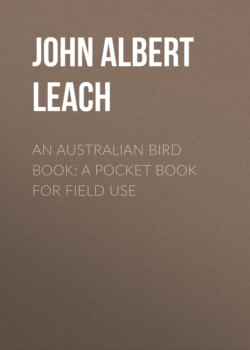Читать книгу An Australian Bird Book: A Pocket Book for Field Use - John Albert Leach - Страница 17
На сайте Литреса книга снята с продажи.
ORDER IV.—COLUMBIFORMES, PIGEONS, DOVES.
ОглавлениеTable of Contents
F. 16. TRERONIDAE (8), FRUIT-PIGEONS, 228 sp—159(155)A., 60(56)O., 1(1)P., 12(12)E.
2
2
12 Topknot Pigeon, Lopholaimus antarcticus, E.A., T. (acc.) "Quook-quook."
Stat. c. thick brushes 17
"This noble pigeon;" under silvery-gray; upper dark-gray; crest rust-red; eyes orange; f., sim. Native fruits.
F. 17. COLUMBIDAE (2), WOOD-PIGEONS, Passenger-Pigeon, Rock-Dove, 119 sp.—41(40)A., 25(17)O., 18(10)P., 19(17)E., 4(0)Nc., 24(20)Nl.
F. 18. PERISTERIDAE (15), GROUND-PIGEONS, Turtle-Doves, 198 sp.—61(55)A., 21(8)O., 10(1)P., 32(30)E., 10(0)Nc., 86(76)Nl.
1
6
12a Indian Turtle-Dove, Turtur ferrago, Siberia to Ceylon, introduced A.
Mig. c. gardens, cities 13
Back brown; head gray; broad patch side and back of neck black spotted white; breast cinnamon; centre tail feathers blackish, rest tipped white; f., sim. Seeds.
3
5
13 Ground Dove (Peaceful), Doo-doo, Geopelia placida, A. (interior).
Stat. r. grassy 8.7
Upper ashy-brown, barred black; chest, hind-neck gray with black lines; abdomen fawn; side tail feathers tipped white; f., sim. Small seeds. "Doo-doo."
14* Diamond Dove (Little, Turtle), G. cuneata, A. (interior).
Stat. r. grass 8.2
Upper light-brown; crown gray; under light-gray; white spots on wing; side tail tipped white; eye red; f., neck, chest pale brown. Seeds.
1
6
15 Little Green Pigeon, Chalcophaps chrysochlora, Mol., N. Heb., N. Cal., Lord Howe Is., A. exc. S.A., W.A. Melancholy bellowing note.
v.r. dense scrubs 9.5
Rich brown; head, short tail darker; wings much green; shoulder white; f., less brilliant. Fallen berries.
2
2
16* Bronzewing Pigeon (Scrub), Phaps chalcoptera, A., T.
Nom. c. open, forest 13.5
Upper brown marked lighter; cap whitish; line below eye, throat white; breast, back of head vinous; bronze wing; legs red; f., head gray. Seeds, fruits.
17 Brush Bronzewing Pigeon (Little Bronze), P. elegans, A., T.
Nom. r. sandy 13
Upper chestnut-brown; breast blue-gray; throat, crown chestnut; bronze wings; f., crown gray. Seeds.
1
1
18 Crested Pigeon (Topknot (e), Crested Bronzewing), Ocyphaps lophotes, A. Seeds.
Nom. r. inland plains 13
Upper fawn; crown, under gray; crest black; black bars on wings; tail tipped white; eyes orange; f., sim.
1
1
19 Wonga-Wonga Pigeon, Leucosarcia melanoleuca, E.A. Seeds, fallen fruits.
Stat. r. coast-, (hillside-) brushes 15
Back, breast slaty-gray; wings brown; crown, throat, abdomen white; sides spotted black; f., sim.
F. 19. Gouridae, Crowned Pigeons, 8 sp. A. (N.G.).
F. 20. Didunculidae, Tooth-billed Pigeons, 1 sp. A. (Samoa).
F. 21. Opisthocomidae, Hoactzin, 1 sp. Nl.
The birds of Order V. are amongst the successes in the struggle for existence, for they are found the world over.
The Landrail or Corn-Crake, the Little Crake, Spotted Crake, Moor-Hen, Purple Gallinule, and the lobed-toed Coot, of other countries, are represented by similar birds here.
They are largely swamp-dwellers, and conditions about swamps apparently do not vary much from continent to continent. There is a full supply of vegetable and animal food, and there is good shelter in the thick reed-beds. The smaller members of the family are seldom seen, for they skulk amongst the reeds, and seldom show themselves.
Many of these birds are long-toed, and are beautifully adapted for life about the soft mud and floating vegetation of lagoons and swamps. Though the feet are not webbed, several of these swamp-dwellers swim well. Thus the Little Crake is an expert swimmer and diver.
There is one Australian bird not represented in other countries. This is the handsome, bantam-like Black-tailed Native-Hen. At long intervals the birds appear in thousands, and, being largely vegetable feeders, they have sometimes done considerable damage to crops.
During one such irruption in 1846, the birds invaded the streets of Adelaide. Others invaded the Geraldton district, and even reached Perth in 1886. Northern Victoria was visited in 1909.
Some of the members of this group are known to all; indeed, when you have finished reading this lecture, I expect to have created in your mind an idea that bird study is very simple—that you know at least one of each of the groups of birds. One further advantage of bird study is that so few birds are found in any district. Thus, only 880 birds have ever been recorded from Australia, whereas there are over 9,000 kinds of native flowering plants, not to mention non-flowering plants. In very few districts could a list of 100 different kinds of birds be compiled in one year.
Again, while it is impossible to talk popularly of native plants, because they have no common names, that does not apply to birds, for bird-lovers have given a simple name to each bird. Even children, therefore, can talk definitely and exactly about the different kinds. This is a great advantage. Again, as birds are living, moving, loving, and beautiful animals, they have always been favorite objects of study, and so we know more about them than about any other division of the animal kingdom. Thus you will, I hope, find that you know far more about the subject than you at first thought.
